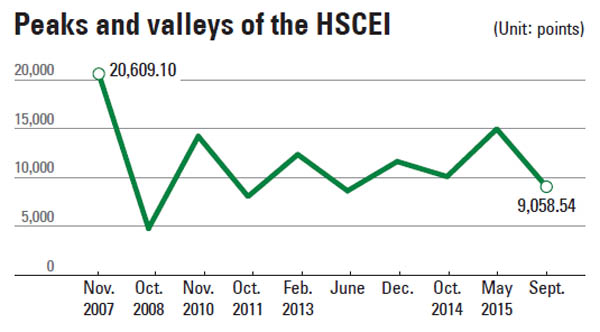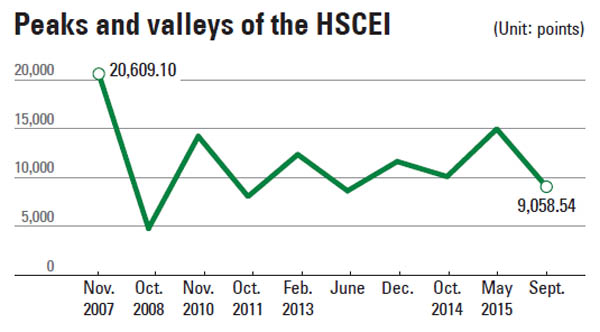As Hong Kong index slides, investors face tough call

But with the latest plunge in the Hong Kong index, he’s been seeing losses on the security. When he bought the product, the HSCEI was hovering over 14,720 points. Now, it’s tumbled to around 9,000. If the HSCEI drops below 8,096, it will trigger a knock-in option - which automatically terminates the product - and lead to big losses.
“I’m not sure if I should sell it now or just leave it,” he said.
Lee isn’t the only one with the dilemma. Many people who bought an ELS based on the HSCEI are in the same position. The index tracks the performance of Chinese companies based in the mainland and listed on the Hong Kong Stock Exchange, which rallied earlier this year when Chinese stocks skyrocketed. The HSCEI, which lingered around 10,000 in October 2014, jumped to 14,962.74 last May, its highest level ever.

Unfortunately for investors, the HSCEI plummeted amid worries about China’s equity markets. On Sept. 4, it crashed to 9,058 and spurred worries it could finish below 9,000. The index managed to close at 9,169 points, but this was still a 39.4 percent drop from its peak.
Still, fund managers in Seoul say there’s no need to sell off just yet. This is because the HSCEI hasn’t sunk low enough to trigger a knock-in option in most of the ELS products.
Most of the ELS products issued in the spring this year have their knock-in option triggered only if the index falls to between 45 and 55 percent of its value when the product was originally purchased. So even if a person bought an ELS product at its highest point this year with a 55 percent barrier, the knock-in is triggered when the index falls below 8,096. If the ELS was bought when the index was lower than that, around 12,000, the probability of triggering a knock-in would be lower.
According to FnGuide, a financial information provider, and Yuanta Securities Korea, ELS products issued in Korea could see the most losses when the index falls to the level between 6,500 and 7,000, spurring about 3.6 trillion won in estimated losses. Analysts say that the losses start to surpass 1 trillion won only if the index plunges below the 8,000 level.
Given that the index is still hovering over 9,000, there is still time for investors to hold the securities.
The index has only tumbled below 8,000 once, during the 2008 global financial crisis, when it plunged to 4,700. But it rebounded over 8,000 in March 2009 and has never gone below 8,000 since.
“As there are no further factors to pull the index down, buyers don’t have to respond to the recent drop emotionally,” said Lee Jung-won, an economist at Yuanta Securities Korea. “You need to figure out the real scale of the risk.”
BY PARK JIN-SEOK [kim.heejin@joongang.co.kr]










with the Korea JoongAng Daily
To write comments, please log in to one of the accounts.
Standards Board Policy (0/250자)